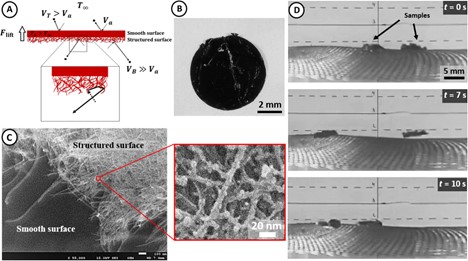Levitation of polymer nanocomposite film upon illumination in upper atmospheric conditions.
Problem:
Airborne objects cannot sustain flight within the mesosphere, the upper layer of the Earth’s atmosphere. This layer, which resides 50-80km above the Earth’s surface, lacks the air density needed for airplane lift yet is too dense for satellite orbit. While unoccupied by airborne objects, the mesosphere is a critical resource for surveillance and climate research. Therefore, the ability to sustain flight in the mesosphere is needed for atmospheric data collection and airspace monitoring.
Solution:
The microscale disks can levitate with illumination. This levitation is sustained under mesospheric pressures and light intensities. The direction of incident light does not affect levitation, allowing for these disks’ real-world applications within the Earth’s atmosphere. These disks may withstand micro-payloads such as weather sensors that collect atmospheric data.
Technology:
Photophoresis uses light to displace gas or liquid particles. This particle movement can result in propulsive forces that lift objects. This photophoretic lifting force is often driven by temperature gradients between the top and bottom of an object. However, this force can also originate from varied surface topologies of an object’s top and bottom surfaces. The inventors leverage this phenomenon by creating mylar disks of submicron thickness. The bottoms of these disks are coated in carbon nanotubes (CNTs). Upon illumination, these CNT networks trap air molecules, which collide with multiple surfaces before escaping with higher velocity. This difference in molecule velocity creates a lifting force that levitates the ultrathin disks.
Advantages:
Disk levitates under 0.5 W/cm2 incident light intensity, comparable to natural sunlight
Levitation achieved under ~10 Pa pressure, comparable to mesospheric pressures
Disk levitation can be controlled and “trapped” by casting rings of higher light intensity
Disks may withstand up to 10 mg payload

Overview of disk and levitating mechanism (A) Schematic of disk surface topology and propulsive force mechanism. While air molecules have single collisions with the disk’s smooth top surface, the carbon nanotubes (CNTs) coating the bottom surface trap incoming air molecules. This leads to multiple collisions and increased escape velocity, which creates an upward lift force on the disk. (B) Macroscale photo of CNT-coated mylar disks, which are ~6mm in diameter. (C) Electron micrograph of top and bottom disk surface topology. While the top mylar surface is smooth, the CNT-coated bottom surface creates a nanofiber network that traps air molecules. (D) Video screenshots in which two disks levitate upon illumination.
Desired Partnerships:
- License
- Co-development
Case ID:
20-9390-tpNCS
Web Published:
5/12/2023
Patent Information:
| App Type |
Country |
Serial No. |
Patent No. |
File Date |
Issued Date |
Expire Date |